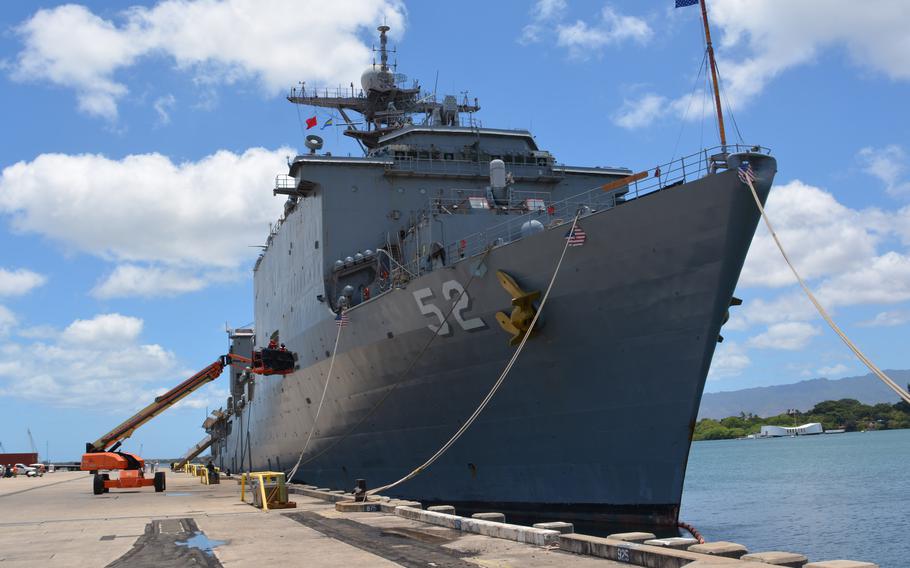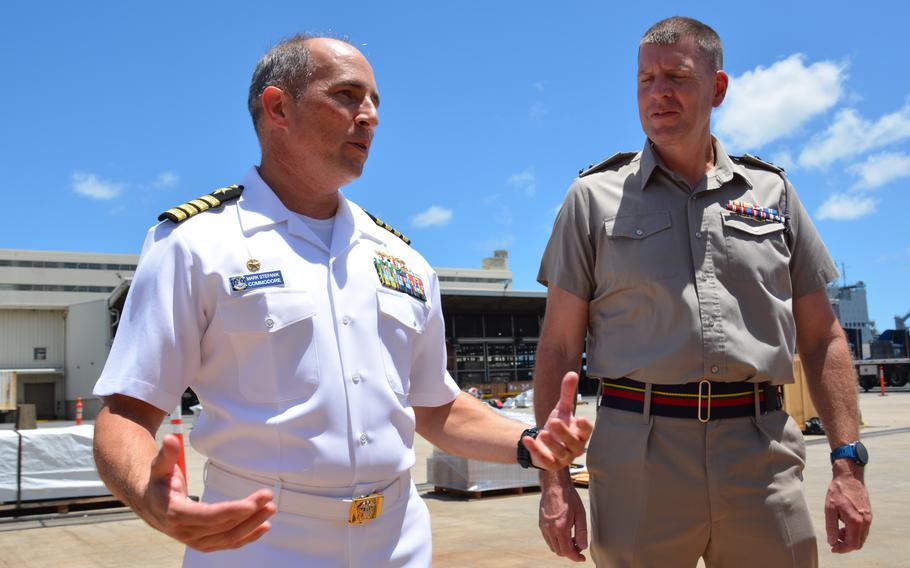
The USS Pearl Harbor, a 600-foot-long amphibious dock landing ship that will serve as flagship for the Pacific Partnership mission, is moored at Joint Base Pearl Harbor-Hickam, Hawaii, on July 10, 2025. (Wyatt Olson/Stars and Stripes)
JOINT BASE PEARL HARBOR-HICKAM, Hawaii — USS Pearl Harbor pulled into its namesake port this week as it prepares to lead the Navy’s largest annual maritime humanitarian and medical assistance mission in the Indo-Pacific.
The amphibious dock landing ship arrived at this joint base on Tuesday and is serving as the flagship for the Pacific Partnership mission lasting through November.
“The USS Pearl Harbor is, in some ways, a large floating truck loaded with all of our medical and construction supplies,” Capt. Mark Stefanik, the mission’s commander, told reporters Thursday while standing dockside of the 600-foot-long ship.
He was joined by Cmdr. Alban Dervishi, the ship’s commanding officer, and United Kingdom Royal Marines Col. Matt Churchward, the mission’s deputy commander.
The amphibious ship “provides a good avenue for U.S. power in the Pacific in terms of being able to provide the material we need for these missions,” Stefanik said.
Defense Secretary Pete Hegseth has declared “lethality” to be the touchstone of the Defense Department under Donald Trump’s second administration, which has instituted deep cuts in foreign aid that have long fostered America’s soft power.
But Pacific Partnership remains in place as a demonstration of America’s willingness to assist its Pacific neighbors.

Capt. Mark Stefanik, left, commander of the Navy’s Pacific Partnership mission, speaks with reporters at Joint Base Pearl Harbor-Hickam, Hawaii, on July 10, 2025. Beside him stands the mission’s deputy commander, United Kingdom Royal Marines Col. Matt Churchward. (Wyatt Olson/Stars and Stripes)
The mission, now in its 21st iteration, focuses entirely on assisting small nations in civic development such as expanding hospitals, schools and infrastructure and preparing for natural disasters.
“We believe that we prepare in calm so that we can respond in crisis,” Stefanik said. “The Navy has been a big, big part of crisis response in the Pacific for all kinds of natural disasters. So if we come in and have the opportunity to build these capacities and build these partnerships — while it’s not a crisis — when we do come, we’re much more effective for all kinds of missions.”
This year’s mission includes visits by the Pearl Harbor to Papua New Guinea, the Federated States of Micronesia, Palau, Samoa and Vanuatu.
Small “fly-in” projects were held last month in the Philippines, Fiji and Tonga.
The hospital ship USNS Mercy has served as the flagship for numerous Pacific Partnership missions in the past, but the Pearl Harbor’s sick bay is serving the medical function this year.
“The hospital ship obviously has a lot more direct-care capability in terms of medical supplies and stuff,” Stefanik said.
On the other hand, he said, the amphibious ship carries a crew of about 300 sailors who can be utilized for mission tasks — manpower that the Mercy does not have.
An amphibious dock landing ship is built to transport Marines to Pacific islands in the event of conflict or assisting during disasters. The ship is designed to sink about 10 feet, allowing water to flood a large bay in the stern that buoys an amphibious boat for delivering the Marines ashore.
The Pearl Harbor is the only American ship on the mission, but it will be joined by South Korean and Japanese vessels during some stops, Stefanik said. Great Britain, Canada and Germany are also helping out on part of the mission, he said.
The six-month mission, which ends Nov. 16 in Vanuatu, is designed to coincide with the Indo-Pacific’s hurricane season “so that we’re out there as a ready force in case something does happen,” he said.